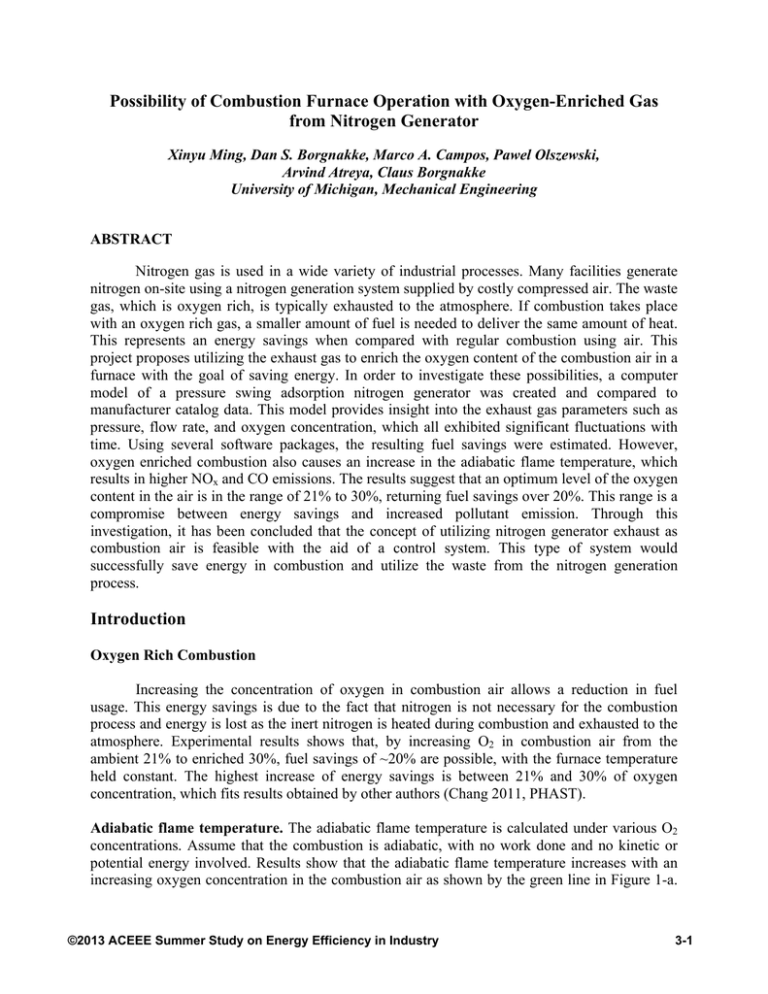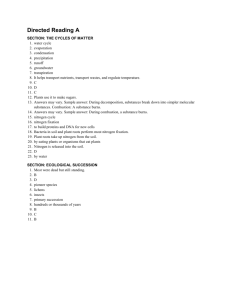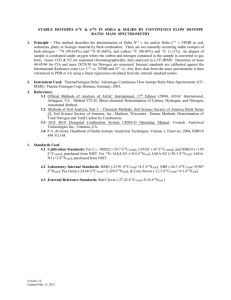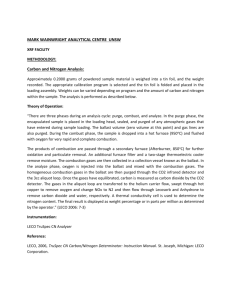Possibility of Combustion Furnace Operation with Oxygen
advertisement

Possibility of Combustion Furnace Operation with Oxygen-Enriched Gas from Nitrogen Generator Xinyu Ming, Dan S. Borgnakke, Marco A. Campos, Pawel Olszewski, Arvind Atreya, Claus Borgnakke University of Michigan, Mechanical Engineering ABSTRACT Nitrogen gas is used in a wide variety of industrial processes. Many facilities generate nitrogen on-site using a nitrogen generation system supplied by costly compressed air. The waste gas, which is oxygen rich, is typically exhausted to the atmosphere. If combustion takes place with an oxygen rich gas, a smaller amount of fuel is needed to deliver the same amount of heat. This represents an energy savings when compared with regular combustion using air. This project proposes utilizing the exhaust gas to enrich the oxygen content of the combustion air in a furnace with the goal of saving energy. In order to investigate these possibilities, a computer model of a pressure swing adsorption nitrogen generator was created and compared to manufacturer catalog data. This model provides insight into the exhaust gas parameters such as pressure, flow rate, and oxygen concentration, which all exhibited significant fluctuations with time. Using several software packages, the resulting fuel savings were estimated. However, oxygen enriched combustion also causes an increase in the adiabatic flame temperature, which results in higher NOx and CO emissions. The results suggest that an optimum level of the oxygen content in the air is in the range of 21% to 30%, returning fuel savings over 20%. This range is a compromise between energy savings and increased pollutant emission. Through this investigation, it has been concluded that the concept of utilizing nitrogen generator exhaust as combustion air is feasible with the aid of a control system. This type of system would successfully save energy in combustion and utilize the waste from the nitrogen generation process. Introduction Oxygen Rich Combustion Increasing the concentration of oxygen in combustion air allows a reduction in fuel usage. This energy savings is due to the fact that nitrogen is not necessary for the combustion process and energy is lost as the inert nitrogen is heated during combustion and exhausted to the atmosphere. Experimental results shows that, by increasing O2 in combustion air from the ambient 21% to enriched 30%, fuel savings of ~20% are possible, with the furnace temperature held constant. The highest increase of energy savings is between 21% and 30% of oxygen concentration, which fits results obtained by other authors (Chang 2011, PHAST). Adiabatic flame temperature. The adiabatic flame temperature is calculated under various O2 concentrations. Assume that the combustion is adiabatic, with no work done and no kinetic or potential energy involved. Results show that the adiabatic flame temperature increases with an increasing oxygen concentration in the combustion air as shown by the green line in Figure 1-a. ©2013 ACEEE Summer Study on Energy Efficiency in Industry 3-1 The red line shows how the adiabatic temperature changes with various oxygen concentrations if considering dissociation using CHEMKIN. 4000 80% 3500 70% Energy savings [%] Adiabatic flame temperature [K] Figure 1-a.) Adiabatic Flame Temperature and b) Fuel Savings 3000 2500 2000 1500 1000 500 0 20% 25% 30% 35% 600 K 1000 K 1400 K 60% 800 K 1200 K 1600 K 50% 40% 30% 20% 10% 0% 20% yO2 [molO2/molGAS] 25% 30% yO2 [molO2/molGAS] 35% Possible energy savings. What we care about the most is how much fuel we can save with enriched oxygen combustion. The amount of energy flowing out with the exit air decreases with increasing oxygen concentration because the amount of nitrogen flowing out decreases. Assume that the exhaust temperature equals the furnace temperature, the percentage of energy savings under three different furnace temperatures are calculated using CHEMKIN and the results are shown in Figure 1-b. The amount of energy produced by combustion with 21% oxygen in the combustion air is used as a reference. As the oxygen concentration in the combustion air increases, more energy is available from the combustion thus less fuel is required. When oxygen concentration increases from 21% to 40%, energy saving of 60% can be achieved. Note that this is the ideal situation when we assume that the exhaust temperature is constant, while in the real case it increases and thus there will be reduced savings. Figure 2. Fuel Savings from Oxygen Enrichment in Preheated Furnace 30 300K Fuel Savings [%] 25 400K 20 500K 15 600K 10 800K 5 1000K 0 0.21 1200K 0.23 0.25 0.27 0.29 0.31 0.33 0.35 yO2 [molO2/molGAS] 3-2 ©2013 ACEEE Summer Study on Energy Efficiency in Industry Energy savings with preheating. Preheating the combustion intake air going into the burners can lead to more potential savings. By installing a heat exchanger onto the exhaust of the furnace, one can recuperate some of the energy created by the high temperature of the flue gasses and transfer it to the combustion air. Therefore, many industrial furnaces utilize regenerators, devices that preheat incoming combustion air with outgoing flue gases. Figure 2 shows the fuel savings that can be obtained by increasing combustion air oxygen content in a furnace that already implements preheating. Results were obtained using the PHAST program, in which the oxygen concentration was gradually increased. It is possible to observe that as the oxygen concentration of the air is increased, the fuel savings increase accordingly. Each line represents a different combustion air preheat temperature. Nitrogen Generation The most common nitrogen generation technologies are: pressure swing adsorption (PSA), membrane separation, vacuum swing adsorption (VSA), and cryogenic. Pressure swing adsorption nitrogen generators are among the most common in industry today, with production of up to 5,000 nm3/hr with N2 purities up to 99.9995%. Membrane separation systems are also common in industry, and are comparable to PSA systems, producing up to 5,000 nm3/hr with N2 purities up to 99.99%. Vacuum swing adsorption nitrogen generation systems are less common, typical production ranges below 1,000 nm3/hr with N2 purities up to 99.4%. However, VSA technology has several advantages, including lower energy input requirements and high oxygen purity exhaust when compared to other nitrogen generation technologies. Cryogenic nitrogen generation systems can be sized to produce almost unlimited amounts of N2 at very nearly 100% purity, but are not economical for nitrogen requirements below 5,000 nm3/hr, and will therefore not be addressed in this investigation. Membrane separation. In membrane separation nitrogen generation systems, ordinary dry compressed air is filtered and passed through a technically advanced bundle of hollow membrane fibers. Nitrogen is separated from the feed air by selective permeation across the surface of the membrane fibers. Water vapor and oxygen rapidly permeate safely to the atmosphere, while the nitrogen gas is discharged under pressure into the distribution system. Pressure swing adsorption. The nitrogen generation plants based on the pressure swing adsorption (PSA) process (Figure 3) consist of two or more adsorption towers filled with a carbon molecular sieve (CMS) material. Compressed and purified air is introduced to one of the adsorption towers. The CMS material absorbs oxygen molecules, leaving nitrogen enriched gas passing through the adsorption tower. After one to two minutes, depending on desired nitrogen purity, of adsorption in one tower, the process controller switches a valve to begin the adsorption process in the second tower, and regenerate the first. The regeneration process consists of depressurization of the adsorption tower, thus purging the oxygen molecules that were trapped in the CMS material during the adsorption process. The gas flow velocity through the CMS bed determines the remaining oxygen concentration in the nitrogen produced. By changing this velocity, the oxygen concentration can be adjusted very easily to less than 1 ppm. The basic PSA cycle consists of four steps: pressurization by product or feed, adsorption of components during high-pressure feed step, desorption during depressurization step, and final clean-up by purified product in the purge step. The cycle is usually carried out in two adsorption ©2013 ACEEE Summer Study on Energy Efficiency in Industry 3-3 columns. The recovery of the components is improved by incorporating a pressure equalizing step, in which the high pressure in one tower is used to begin the pressure increase in the other tower after it has been regenerated. These two steps do not change the qualitative behavior of the PSA system. Closely related to pressurized PSA systems, vacuum PSA systems operate on the same basic principles, but utilize high-efficiency, low pressure blowers instead of compressed air. However, pressurized PSA systems are the most common on-site nitrogen generation technologies found in industry today. Therefore, the following investigation will consider the use of a pressurized PSA nitrogen generator. System Characteristics A furnace with an inert atmosphere of nitrogen gas provided by a pressure swing adsorption nitrogen generator is shown in Figure 3. This research investigates taking the vent gas from the nitrogen generator and using it in the natural gas burners that power the furnace. The vent gas pressure and oxygen content are fluctuating; therefore, it must be conditioned to provide a constant flow before being delivered to the individual burners. Each burner is fed with this mixture and a supply of natural gas so they are adjusted for appropriate equivalence ratio. The furnace operating temperature depends on the process which can be heating of metal before hot stamping or heat treatment in general. Figure 3. System schematic For the analysis of this system, we assume the exhaust gases are at the set furnace temperature and that we have a stoichiometric ratio of fuel assumed to be methane, CH4, and the oxygen enriched gas. To maintain a constant temperature in the furnace, a certain rate of heat transfer from the combustion gas is required. The energy balance for the flow through the furnace then becomes % % As the oxygen content of air is increased, there is less nitrogen present both in the flame and in the exhaust. This causes the energy (enthalpy) difference between the flame-temperature gas ( ) and the exhaust ( ) to become higher. For the same heat transfer this leads to a lower required flow rate ( ), which is proportional to fuel consumption. 3-4 ©2013 ACEEE Summer Study on Energy Efficiency in Industry Flow Characteristics of PSA Vent Based on manufacturer catalog data, average oxygen concentration in the vent gas has been calculated for long-term operation, and can be found below in Figure 4 (Atlas Copco, Innovative Gas System). The average oxygen concentration can be used to calculate average oxygen output over a long period of operation. Figure 4. Vent Gas Oxygen Concentration for Various N2 PSA Generator Capacities yO2 [molO2/molGAS] 0.32 0.31 0.30 0.29 0.28 0 200 400 600 800 Generator capacity [nm3/h of N2] 1000 1200 Flow characteristics of the vent gas have been predicted for three example scenarios being solutions from our own developed numerical code based on Langmuir isotherms (Langmuir 1918). The simplest model of the PSA process contains 4 cycles (Grande 2012, Cruz 2003, Ahari 2008, Mostamand 2011, Teague 1999): high pressure adsorption, blow down, purge and pressurization. The assumptions made in our model can be found in Figure 5. ©2013 ACEEE Summer Study on Energy Efficiency in Industry 3-5 Figure 5. Assumptions Made for the PSA System Model Based on the literature review, the following assumptions are made for the preliminary model: Gaseous phase described by the ideal gas law Axial symmetrical 2D adsorption process occurs in relatively small volume compare to 1D flow Isothermal process Neglected pressure drop along beds The equilibrium state governed by the Langmuir isotherms Mass transfer rate expressed by Linear Driving Force equations The important feature of the system for the current investigation is that the vent gas conditions are not stable. Pressure, flow rate, and oxygen concentration vary significantly with time, as seen in Figure 6. V [nm3/h] P [kPa] yO2 [molO2/molGAS] Figure 6. Variety of Vent Gas Parameters for Various N2 PSA Generator Configurations 3-6 Set 1 Set 2 Set 3 1.00 0.75 0.50 0.25 0.00 1000 750 500 250 0 3000 2000 1000 0 0 30 60 90 120 150 180 Time [s] 210 240 270 30 ©2013 ACEEE Summer Study on Energy Efficiency in Industry The simulation data based on the model fits the manufacturers’ catalog data, where average oxygen concentration varies between 30% - 33% (Fig. 5 and 6). System Design A control system must be implemented in order to utilize a fluctuating flow of nitrogen generator exhaust as combustion air in a furnace. A preliminary design of such a system is presented below in Figure 7. Vent gas from the nitrogen generator is collected in a buffer tank, in which vacuum pressure is maintain by a vent blower, to secure appropriate operating conditions for the generator itself. Because of cyclic operation, a vent blower can be controlled by a signal from the nitrogen generator or pressure gauge installed in the buffer tank. To achieve a consistent oxygen concentration, the vent gas is forced into a storage tank at higher pressure. A one-way-valve prevents back flow when the blower is not operating. The gas then flows through reduction and regulation valves, after which it is mixed in an appropriate ratio with supplementary air. An oxygen sensor measures the oxygen concentration of the gas to control the flow rate of the atmospheric air (by Variable Speed Drive blower). Pressure is maintained at slightly higher level than it is required for the burners in the combustion air tank, to ensure proper delivery. The final flow rate of oxygen enriched combustion air is controlled by a regulation and shutoff valve. Figure 7. Vent Gas Damping System Design System Benefits Fuel Savings The primary benefit of oxygen enriched combustion is the fuel savings. However, oxygen enrichment using pure oxygen is prohibitively expensive. Utilizing the exhaust gas from an already existing nitrogen generator would have a very low cost per unit volume of oxygen enriched combustion air. Once such a system is installed, the only costs would be the electricity to power the system, as well as maintenance. As described above, the system would require a low pressure blower, which would consume electricity based on its capacity. The fuel savings resulting from the implementation of the system would depend on the capacities of both the nitrogen generator and furnace operated at the facility in question. If the furnace combustion ©2013 ACEEE Summer Study on Energy Efficiency in Industry 3-7 requires more oxygen than is output by the nitrogen generator exhaust, ambient air must be mixed with the exhaust gases to provide the necessary oxygen flow rate. The mixing of ambient air with nitrogen generator exhaust decreases the oxygen concentration, thus decreasing fuel savings percentage. The percentage of fuel savings achieved by oxygen enrichment for different combinations of nitrogen generator capacity and furnace fuel consumption have been calculated and presented below in Figure 8. The nitrogen generator exhaust is assumed to contain 30% oxygen, the average of a range of different models. The fuel savings percentages were calculated using the Department of Energy PHAST program, operating under the assumption that the furnace temperature is 1200 K, the furnace temperature is equal to the flue gas temperature, combustion air intake temperature of 20°C, and 5% oxygen in the furnace exhaust gases (PHAST). The cost of electricity to operate the oxygen enrichment system has been taken into account in the cost analysis. As seen below, up to 18% fuel savings can be achieved with the optimal combination of nitrogen generator and furnace fuel consumption. Figure 8. Energy Savings for Combinations Of Furnace And Nitrogen Generator Capacities 14 108.9 12 54.1 10 8 36.5 6 23.5 4 12.4 2 Energy savings possibility [%] 16 247.2 50 30 18 14 10 6.0 4.0 2.0 1.0 0.9 0.7 0.5 0.3 0 0.1 Nitrogen generator capacity [SCFM of N2] 18 Natural gas usage [MMBTU/hr] Carbon Dioxide Emission Carbon dioxide emissions have a negative impact on the environment, and are therefore regulated. The amount of carbon dioxide formed during combustion depends directly on the amount of fuel consumed. One mole of carbon dioxide is produced for every mole of fuel burned, according to the stoichiometric equation for combustion of methane in air. Oxygen enriched combustion allows less fuel to be consumed to maintain the same furnace performance as combustion with ambient air. Therefore, less carbon dioxide is formed as a result of burning 3-8 ©2013 ACEEE Summer Study on Energy Efficiency in Industry less fuel. Carbon dioxide emissions would be reduced by the same percentage as fuel consumption would be reduced in an oxygen enriched combustion system. Potential problems CO and NOx Emission in Oxygen Enriched Combustion The drawback of increasing oxygen concentration in the combustion air is higher pollutant emissions. A higher temperature leads to increasing NO2 emission, and more oxygen leads to increasing CO and NO emission. Higher levels of NOx formation are caused by higher flame temperature and oxygen concentration in the combustion air (Tan 2002). According to the experimental results from Wu and Chang, the NOx emission showed exponential growth with temperature, it increased sharply from 30.95 to 137.29 mg/MJ as the O2 concentration increased from 21% to 30% (Chang 2011). Calculations of the CO and NOx emission at equilibrium states were conducted using CHEMKIN. Using this program, combustion of natural gas with constant pressure and enthalpy was simulated with oxygen concentration varying from 21% to 40%. The results are shown in Figure 9, indicating that both CO and NOx formation increase with increasing oxygen concentration in the combustion air. These results are mainly due to the increase in flame temperature, and have been verified with other similar programs. As the flue gases exit the system, their temperature decreases steadily. This decrease in temperature will lead to an oxidation of CO to form CO2, while the NOx concentration typically remains the same. Figure 9. CO and NOx Formation 0.06 3.5E-06 CO NO NO2 3.0E-06 0.05 2.5E-06 0.04 2.0E-06 0.03 1.5E-06 0.02 1.0E-06 0.01 5.0E-07 yNO2 [mol/molEX] yCO, yNO [mol/molEX] 0.07 0.0E+00 0 21% 22% 23% 24% 25% 26% 27% 28% 29% 30% yO2 [molO2/molGAS] Case Study The University of Michigan Industrial Assessment Center team visited a hot-stamping plant which utilizes an oxygen-free, nitrogen-rich environment in its furnaces. The nitrogen gas required for this enriched atmosphere is provided by a nitrogen generator. The oxygen-rich gas ©2013 ACEEE Summer Study on Energy Efficiency in Industry 3-9 that is left over after the nitrogen generation can be used as combustion air for the natural gas furnace. According to the information obtained on site, the nitrogen generator produces 99% purity nitrogen at a rate of 6,000 scf/hr. The nitrogen generator also produces vent gas (assumed to be 30% O2) at an estimated rate of 15,000 scf/hr. Preliminary calculations also show that, to increase the oxygen concentration in the combustion air to 26% for each burner (50% load, 0.05 MMBtu/hr each), the amount of vent gas required is 85.3 scf/hr. The information for all the furnaces in the plant is shown in Table 1. Furnace Number #1, #2 #3, #4 Table 1. Summary of Furnaces in the Plant Numbers of Burners Power of Burners 45 0.05 MMBtu/hr each 63 0.05 MMBtu/hr each Vent Gas Required 3,840 scf/hr/furnace 5,380 scf/hr/furnace If this project is implemented in furnaces #1, #3, and #4, according to our calculations, the energy savings for each furnace is estimated to be about 15%. The unit cost for natural gas in this hot-stamping plant is $6.34/MMBtu. Therefore, this project brings an annual energy cost savings of approximately $31,540. Table 2. Implementation Cost Part Units Unit Price Buffer tank, combustion air tank 100 gal 2 $1,500 Storage tank 200 gal 1 $2,500 Air blower 200 SCFM 1 $500 High pressure blower 200 SCFM 1 $2,000 Reduction valve 1 $500 Regulation valve 2 $500 Oxygen sensor 1 $1,500 Additional piping, other materials $2,000 Labor cost (200 hrs) 200 $40/hr Total Price $3,000 $2,500 $500 $2,000 $500 $1,000 $1,500 $2,000 $8,000 $21,000 As seen above in Table 2, the total implementation cost is estimated at about $21,000. If the system achieves the expected annual fuel savings, the payback period would be about 8 months. Conclusions The majority of nitrogen generators in use today vent their oxygen rich exhaust gas to the atmosphere. This exhaust gas is an easily accessible and cheap source of oxygen rich combustion gas for use in a combustion furnace. Based on manufacturers’ data and computer modeling, the oxygen concentration of the exhaust gas has been found to be about 30% (Figure 4). Through modeling, the fluctuation of several exhaust gas parameters, such as pressure, flow rate, and O2 concentration have been found to be substantial (Figure 6). Therefore, a system of tanks, valves, and pressure regulators that is capable of receiving the variable flow of oxygen rich exhaust and delivering a steady flow of oxygen enriched combustion air to a furnace was designed (Figure 7). This system also includes a device that mixes oxygen rich nitrogen generator exhaust with 3-10 ©2013 ACEEE Summer Study on Energy Efficiency in Industry atmospheric air, which decreases oxygen concentration, but increases overall flow rate to provide enough air for the furnace. Oxygen enriched combustion increases adiabatic flame temperature and decreases the amount of inert gas present during combustion (Figure 1-a). These effects, combined with preheating combustion air, result in energy savings above 30% (Figure 2). Increasing the oxygen concentration also increases NOx and CO emissions (Figure 9). However, the increases in harmful emissions are minimal when the combustion air oxygen concentration is below 30%. A practical case study indicates that the payback period for the implementation of an oxygen enrichment system can be less than one year, making this type of system economically feasible. References Ahari J. S, Pakseresht S., Determination Effects of Process Variables on Nitrogen Production PSA System by Mathematical Modeling, Petroleum & Coal 50 (2), 52-59, 2008 Atlas Copco, PSA Nitrogen Generators, NGP http://www.atlascopco.com/microsites/Images/2935%200970%2040_tcm4743505910.pdf Series Chang Y.C., Wu K.K., Influences of Oxygen-enriched Combustion Air on Combustion Characteristics of Industrial Furnaces, 2011 Cruz P., Santos J. C., Magalhaes F. D., Mendes A., Cyclic adsorption separation processes: analysis strategy and optimization procedure, Chemical Engineering Science 58 (2003) Dutton J. C., Coverdill E. R. Experiments to Study the Gaseous Discharge and Filling of Vessels, Int. J. Eng. Ed. Vol. 13, No. 2, p. 123-134, 1997 Feng X., Ivory J., Development of hollow fiber membrane systems for nitrogen generation from combustion exhaust gas. Part I. Effects of module configurations, Journal of Membrane Science 176 (2000) 197–207 Grande A. C., Advances in Pressure Swing Adsorption for Gas Separation, ISRN Chemical Engineering Volume 2012, Article ID 982934, doi:10.5402/2012/982934 Innovative Gas Systems, NITROSWING Nitrogen global.com/nitroswing/nitrogen-psa-generator.pdf Generators, http://www.igs- Ivanova S., Lewis R., Producing Nitrogen via Pressure Swing Adsorption, American Institute of Chemical Engineers (AIChE), June 2012 CEP Kennedy LA, Saveliev AV, Bingue JP, Fridman AA, Filtration combustion of a methane wave in air for oxygen-enriched and oxygen-depleted environments, Proc Combust Inst, 29, 2002 Langmuir I., The adsorption of gases on plane surfaces of glass, mica and platinum. Journal of the American Chemical Society, Volume 40, 1918. Mostamand A., Mofarahi M., Simulation of a Single Bed Pressure Swing Adsorption for Producing Nitrogen, ICCEBS'2011 Proceedings Bangkok Dec., 2011 PHAST: Process Heating Assessment and Survey http://www1.eere.energy.gov/industry/bestpractices/software_phast.html ©2013 ACEEE Summer Study on Energy Efficiency in Industry Tool, 3-11 Poirier D, Grandmaison EW, Lawrence AD, Matovic MD, Boyd E. Oxygen enriched combustion studies with the low NOx CGRI burner. IFRF Combust, 2004 Schulte-Schulze-Berndt A., Krabiell K., Nitrogen generation by pressure swing adsorption based on carbon molecular sieves, Gas Separation & Purification, Vol.7 No 4, 1993 Tan Y, Douglas MA, Thambimuthu KV. CO2 capture using oxygen enhanced combustion strategies for natural gas power plants. Fuel, Vol.81:1007–16, 2002 Teague G., K., Thomas E., F., Predictive Dynamic Model of a Small Pressure Swing Adsorption Air Separation Unit, Ind. Eng. Chem. Res. 1999, 38, 3761-3775 3-12 ©2013 ACEEE Summer Study on Energy Efficiency in Industry



